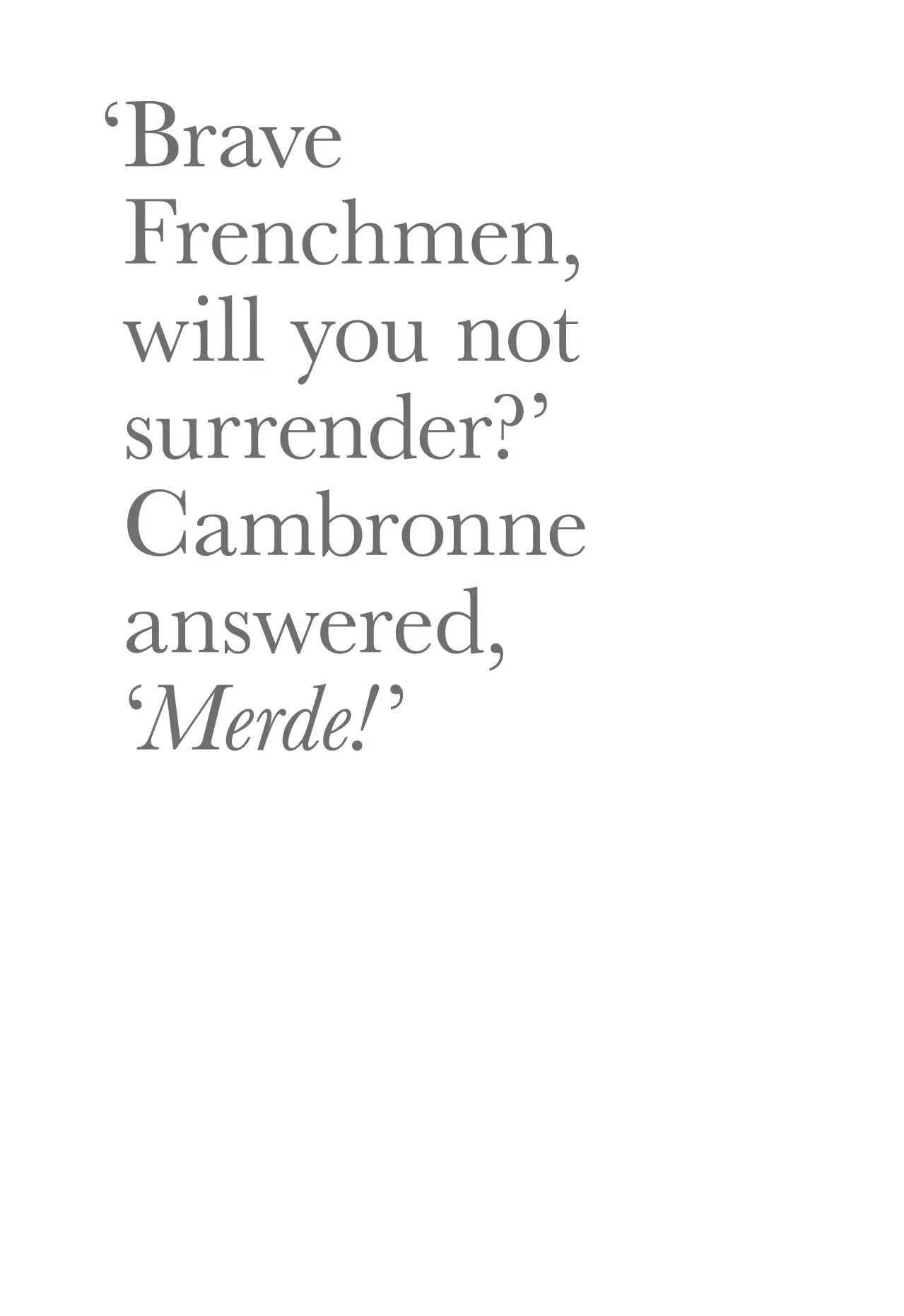Waterloo

Victor Hugo
WATERLOO
Translated by
Norman Denny

Contents
18 June 1815
Follow Penguin
VICTOR HUGO
Born 1802, Besançon, France
Died 1885, Paris, France
Les Misérables was first published in 1862.
This translation was first published in 1976.
VICTOR HUGO IN PENGUIN CLASSICS
Les Misérables
Notre-Dame de Paris


18 June 1815
Had it not rained in the night of 17–18 June 1815, the future of Europe would have been different. A few drops of water, more or less, were what decided Napoleon’s fate. Providence needed only a downpour of rain to make Waterloo the retort to Austerlitz. An unseasonably clouded sky sufficed to bring about the collapse of a world.
The Battle of Waterloo could not start until eleven-thirty because the ground was too wet. It had to dry out a little before the artillery could manoeuvre. And it was this that enabled Blücher to arrive in time.
Napoleon was an artillery officer and never forgot it. At the heart of this prodigious commander was the man who had reported to the Directory after the Battle of Aboukir, ‘Some of our shot killed six men.’ All his battle-plans were designed to suit the heavy armament. To bring the artillery to bear on the critical point, this to him was the key to victory. He treated the enemy general’s strategy as though he were attacking a fortress, and he breached it. He pounded the weak points with grape-shot, and shaped and resolved battles with cannon-fire. His was a marksman’s genius. To beat in the squares, pulverize the regiments, break the lines, maul and scatter the mass, this was the secret – ceaseless hammering – and it was done by the use of cannon. This formidable procedure, applied with genius, rendered him invincible for fifteen years, a dark master of the pugilism of war.
He relied more than ever on artillery in that June of 1815 because he had the advantage of numbers. Wellington had only 159 guns; Napoleon had 240.
Had the ground been dry, so that the artillery could move, the battle would have begun at six in the morning; it would have been over and done with by two, three hours before the Prussians could turn the scales.
How much of the blame for his defeat is to be attributed to Napoleon? Is the navigator necessarily responsible for the shipwreck?
Was Napoleon’s undeniable physical decline at this stage accompanied by a weakening of his faculties? Had twenty years of warfare worn the blade as well as the scabbard, the soul as well as the body? Was the veteran becoming sadly manifest in the commander? In a word, was his genius fading, as many reputable historians believe, and was he frenziedly seeking to hide the fact from himself? Was he beginning to waver under chance setbacks, or – a grave weakness in a general – was he becoming careless of danger? Is there a point in the lives of men who may be termed the giants of action when their vision becomes clouded? Age is no threat to the great men of the mind. With the Dantes and the Michelangelos, to grow older is to grow: is it to shrink, in the case of the Hannibals and the Bonapartes? Had Napoleon lost his flair for victory? Was he no longer able to foresee the pitfall, to detect the trap, to discern the crumbling edge of the abyss; had he lost his instinct for averting disaster? He who had travelled all the roads to triumph, pointing the way with a lordly finger from his fiery chariot, was he now so locked in obsession as to lead his tumultuous following of legions over the precipice? Had he, at the age of forty-six, gone finally mad? Had this titanic coachman of destiny become no more than a breakneck driver?
We do not believe this.
His plan of battle, it is generally acknowledged, was masterly. It was to drive straight for the gap between the Allied forces and divide them in two, pushing the British towards Hal and the Prussians towards Tongres, and making of Wellington and Blücher two separate segments. Mont-Saint-Jean was to be carried and Brussels seized, the Germans flung back to the Rhine and the English into the sea. All this Napoleon intended to achieve by means of this battle; after which he would review the position.
It goes without saying that we do not claim to be writing a history of Waterloo. A critical moment in our tale is linked with the battle, but its history is not our concern. This has, in any case, been admirably recounted by Napoleon himself, from one point of view, and from other aspects by a galaxy of historians.
For our part, we leave to the experts their task, being ourselves no more than a remote observer, a traveller across the plain, scrutinizing that earth sodden with human blood and perhaps mistaking the appearance for the reality. We are not competent to deal in scholarly terms with a mass of facts in which, no doubt, there is an element of illusion, nor do we possess the military or strategic competence which would enable us to assess them professionally. It appears to us that a series of hazards dictated the course of events at Waterloo; and as for Destiny, that mysterious culprit, we judge it like those simple-minded judges, the common people.
‘A’
To form a clear idea of the Battle of Waterloo we have only to draw a capital A. The left leg of the A is the road from Nivelles, the right leg is the road from Genappe, and the cross is the sunken lane from Ohain to Braine-l’Alleud. The point of the A is Mont-Saint-Jean, where Wellington was. The foot of the left leg is Hougomont, where Reille and Jerome Bonaparte were, and the foot of the right leg is La-Belle-Alliance, Napoleon’s headquarters. A little below the point where the cross of the A meets the right leg is La-Haie-Sainte; and the middle of the cross is the precise spot where the battle was decided. That is where the lion has been placed, and unwitting symbol of the supreme heroism of the Imperial Guard. The triangle formed by the upper part of the A is the plateau of Mont-Saint-Jean, the struggle for which was the essence of the battle.
The wings of the two armies extended to right and left of the roads from Genappe and Nivelles, d’Erlon facing Picton and Reille facing Hill. Beyond the apex of the A and the plateau of Mont-Saint-Jean lies the forest of Soignes.
As for the plain itself, imagine a wide rolling landscape, each successive fold dominating its predecessor, the whole rising to Mont-Saint-Jean and ending in the forest.
Two hostile armies on a field of battle are like two wrestlers, bodies interlocked, each seeking to throw the other. Everything is turned to account, the thicket becomes a strong-point, the angle of a wall a buttress.
1 comment